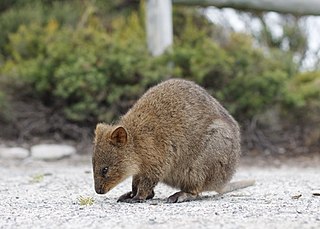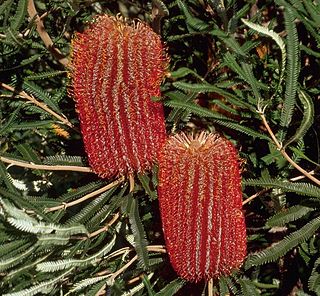Related Research Articles

Banksia is a genus of around 170 species of flowering plants in the family Proteaceae. These Australian wildflowers and popular garden plants are easily recognised by their characteristic flower spikes, and woody fruiting "cones" and heads. Banksias range in size from prostrate woody shrubs to trees up to 30 metres (100 ft) tall. They are found in a wide variety of landscapes: sclerophyll forest, (occasionally) rainforest, shrubland, and some more arid landscapes, though not in Australia's deserts.

The quokka is a small macropod about the size of a domestic cat. It is the only member of the genus Setonix. Like other marsupials in the macropod family, the quokka is herbivorous and mainly nocturnal.

In paleontology, a Lazarus taxon is a taxon that disappears for one or more periods from the fossil record, only to appear again later. Likewise in conservation biology and ecology, it can refer to species or populations that were thought to be extinct, and are rediscovered. The term Lazarus taxon was coined by Karl W. Flessa and David Jablonski in 1983 and was then expanded by Jablonski in 1986. Paul Wignall and Michael Benton defined Lazarus taxa as, "At times of biotic crisis many taxa go extinct, but others only temporarily disappeared from the fossil record, often for intervals measured in millions of years, before reappearing unchanged". Earlier work also supports the concept though without using the name Lazarus taxon, like work by Christopher R. C. Paul.

Banksia goodii, commonly known as Good's banksia, is a species of prostrate shrub that is endemic to a small area in the south-west of Western Australia. It has densely hairy stems, wavy, oblong to egg-shaped leaves with irregularly serrated margins, rusty-brown flowers and hairy fruit. It grows in low forest and woodland near Albany and is listed as "endangered".

Banksia brownii, commonly known as feather-leaved banksia or Brown's banksia, is a species of shrub that grows in southwest Western Australia. A plant with fine feathery leaves and large red-brown flower spikes, it usually grows as an upright bush around two metres (6.6 ft) high, but can also occur as a small tree or a low spreading shrub. First collected in 1829 and published the following year, it is placed in Banksiasubgenus Banksia, section Oncostylis, series Spicigerae. There are two genetically distinct forms.

The Colletidae are a family of bees, and are often referred to collectively as plasterer bees or polyester bees, due to the method of smoothing the walls of their nest cells with secretions applied with their mouthparts; these secretions dry into a cellophane-like lining. The five subfamilies, 54 genera, and over 2000 species are all evidently solitary, though many nest in aggregations. Two of the subfamilies, Euryglossinae and Hylaeinae, lack the external pollen-carrying apparatus that otherwise characterizes most bees, and instead carry the pollen in their crops. These groups, and most genera in this family, have liquid or semiliquid pollen masses on which the larvae develop.

Hylaeus is a large and diverse cosmopolitan genus within the bee family Colletidae. This genus is also known as the yellow-faced bees or masked bees. This genus is the only truly globally distributed colletid, occurring on all continents except Antarctica.

Banksia mimica, commonly known as summer honeypot, is a species of prostrate shrub that is endemic to Western Australia. It has wedge-shaped leaves with sharply-pointed teeth on the sides, yellow flowers in heads of up to fifty and oblong, hairy follicles.

The heath mouse is a species of mouse in the subfamily Murinae, the Old World rats and mice, found in Australia.

Hylaeus alcyoneus, commonly known as the banksia bee, is a bee species endemic to Australia where it is commonly found in the coastal heaths of eastern and southern Western Australia. This bee is an important pollinator of Banksia species.
Verticordia argentea is a flowering plant in the myrtle family, Myrtaceae and is endemic to the south-west of Western Australia. It is an erect, open shrub with almost circular leaves and scented, pink and white flowers. It usually grows in sand and is found near Eneabba.
Verticordia aurea, commonly known as buttercups is a flowering plant in the myrtle family, Myrtaceae and is endemic to the south-west of Western Australia. It is a slender, sometimes bushy shrub with a single stem at the base, cylindrical leaves and heads of scented, golden-yellow flowers in spring.

Guichenotia ledifolia is a species of flowering plant in the family Malvaceae and is endemic to the southwest of Western Australia. It is a densely-branched shrub with densely hairy new growth, hairy, linear to oblong leaves and pink to mauve flowers arranged in groups of three to ten.

Persoonia saccata, commonly known as snottygobble, and cadgeegurrup in indigenous language, is a plant in the family Proteaceae and is endemic to the south-west of Western Australia. It is usually an erect shrub and has linear leaves and groups of up to fifty or more irregularly shaped, yellow flowers which are hairy on the outside. It usually grows in woodland dominated by jarrah, marri or large Banksia species.

Eremophila pantonii, commonly known as broombush, is a flowering plant in the figwort family, Scrophulariaceae and is endemic to Western Australia. It is a broom-shaped shrub with narrow leaves which have a hooked tip, and blue or purple, sometimes white flowers in winter and spring.
Elizabeth Morris Exley was an entomologist who researched Australian native bees particularly those in the subfamily Euryglossinae.

Kensington bushland reserve is a significant remnant of Swan Coastal Plain vegetation, that has been reserved in the suburb of Kensington, in Perth, Western Australia, by the state government.

The Department of Biodiversity, Conservation and Attractions (DBCA) is the Western Australian government department responsible for managing lands and waters described in the Conservation and Land Management Act 1984, the Rottnest Island Authority Act 1987, the Swan and Canning Rivers Management Act 2006, the Botanic Gardens and Parks Authority Act 1998, and the Zoological Parks Authority Act 2001, and implementing the state's conservation and environment legislation and regulations. The Department reports to the Minister for Environment and the Minister for Tourism.
Caladenia rosea is a plant in the orchid family Orchidaceae and is endemic to relatively inaccessible, high lateritic plateaux in a high rainfall area in south-western Western Australia. It is a terrestrial orchid with a single hairy leaf and up to three pink flowers on a thin, sparsely-hairy stem. It is similar to Caladenia flava but is distinguished by the perianth being pink to dark pink with prominent red striping and spotting on the dorsal sepal and lateral petals. Caladenia rosea mimics Hypocalymma robustum (Myrtaceae) in terms of flowering time, colour and scent.
References
- ↑ "'Extinct' bee found on the outskirts of Perth". News | The University Of Western Australia. Retrieved 2019-03-24.
- 1 2 3 4 5 Pille Arnold, Juliana; Murphy, Mark V.; Didham, Raphael K.; Houston, Terry F. (26 February 2019). "Rediscovery of the 'extinct' bee Hesperocolletes douglasi Michener, 1965 (Colletidae: Colletinae: Paracolletini) in Western Australia and first description of the female". Journal of Threatened Taxa . 11 (3): 13310–13319. doi: 10.11609/jott.4610.11.3.13310-13319 .
- 1 2 3 4 5 6 Terry Houston (April 2014). "Native Bee – Presumed Extinct | Western Australian Museum". Museum.wa.gov.au. Retrieved 2015-11-08.
- ↑ Michener, C.D. (1965). "A classification of the bees of the Australian and South Pacific regions". Bulletin of the American Museum of Natural History (130): 1–362.
- ↑ "Threatened Species Nomination" (PDF). Department of Biodiversity, Conservation and Attractions. Government of Western Australia. 31 January 2018. Retrieved 2021-02-28.